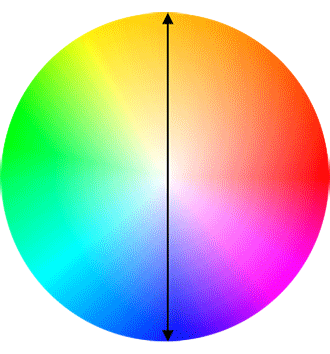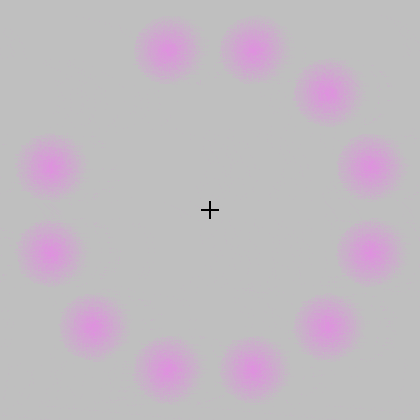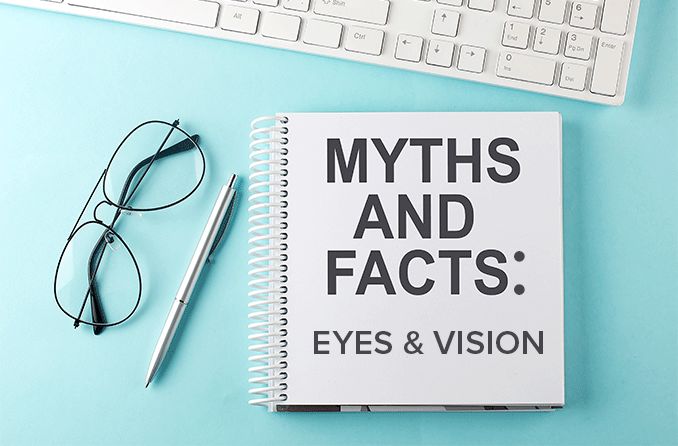Negative afterimages
The color of a negative afterimage is the complementary color of the one you saw in front of you. If you stare at a well-lit, red apple long enough then close your eyes, the negative afterimage of the apple should appear in a shade of green — the complementary color of red.

The colors of a negative afterimage are complementary to the colors of the original image. The royal blue color near the bottom arrow would produce a yellow-orange negative afterimage. [Image credit: "Les Complémentaires " by BARALPO is licensed under CC BY-SA-3.0]
Why does this happen?
The millions of light-sensitive cells along each retina are called rods and cones. The complex process of human vision wouldn’t exist without them.
Rods react to low light and the light in your peripheral vision, while cones specialize in colors, bright light and fine details. When light strikes these cells, they get excited and send a nerve impulse along a pathway toward your brain, where it’s eventually processed as a recognizable stimulus.
But there’s a catch. Like many humans, cone cells don’t like to perform long, tedious tasks. When they’re exposed to the same color for too long, they get tired — or fatigued. This is when other cone cells pick up the slack.
Different cone cells react better to red, green and blue colors, and combine them to form every color in your vision. When certain cone cells get fatigued, the opponent process theory says that inverse-colored cones will pitch in and help out when their counterparts need a break.
Here’s one example of a negative afterimage. It might look like artwork from the 1980s, but it’s actually an afterimage demonstration created by the artist Dimitri Parant.
See that tiny, white dot on the bridge of the woman’s nose? Stare at it closely for 30 seconds. Now close your eyes.
With your eyes closed, you should see a much more lifelike image of a woman. The unnatural colors you were staring at are now gone, and you’re left with a mental image that looks almost like a photograph.
If you focused very carefully, you might even be able to tell that the person floating across your vision is Beyoncé.

The inverse colors in this portrait trick your brain into seeing more lifelike colors when you close your eyes. [Image credit: "BEYONCE, Afterimage" by Dimitri Parant is licensed under CC BY-SA 2.0]
The lilac chaser illusion
Inverted artwork isn’t the only way to experience negative afterimages, as Jeremy Hinton’s “lilac chaser” proves.
Stare at the black cross in the center of this animation and try not to blink. It shouldn’t take too long to notice something strange.
Within a few seconds, the empty space “moving” around the circle will start to look like a green circle. But if you look away from your screen then back again, the green circle is gone — until you stare at the image again.
As you can probably guess, there is no green dot. Instead, it’s an illusion formed by negative afterimages.
Your cone cells get used to seeing the pink dots, so when each one disappears, other cone cells fill their space with a bright green dot — the complementary color of pink. The “rotating” circle moves fast enough that it doesn’t give each afterimage a chance to disappear, so your brain interprets it as a green dot constantly rotating clockwise.
But there’s more to this illusion.
If you stare long enough, the pink dots themselves will start to disappear. But look away again, then come back to the image. The pink dots are back.
This is an entirely different phenomenon called the Troxler effect. When you focus on one point for a long time, the Troxler effect causes the images around that point to slowly disappear.
The phi phenomenon, on the other hand, is what makes you think the circle is moving, when in reality, you’re only looking at a sequence of still images.

The "green" dot in the lilac chaser illusion is a popular example of a negative afterimage. [Image credit: "Lilac-Chaser" by TotoBaggins is licensed under CC BY-SA-3.0]
SEE RELATED: Optical Illusions
Positive afterimages
Unlike negative afterimages, a positive afterimage appears in the same colors as the image in front of you.
They’re also much shorter in duration. You might be able to see a negative afterimage for several seconds, but a positive afterimage usually only lasts half a second or so.
What makes this type of afterimage remarkable is how often you experience them without noticing. Without positive afterimages, it’s possible that movies would look much different.
The average human eye is thought to be able to see around 75 frames per second, but most movie theaters only project movies at 24 frames per second. So why doesn’t a movie look choppy? You may be able to thank positive afterimages for that.
After each frame, a positive afterimage in your eyes maintains the image on the screen for a split second. Together with the phi phenomenon from the lilac chaser illusion, this could explain why humans are able to process smooth “motion” in a motion picture that isn’t actually moving at all.
At this frame rate, a 90-minute movie contains nearly 130,000 individual frames. That’s a lot of positive afterimages — but if phi and afterimages are truly behind movie motion, then they have their limits. Old silent films were once filmed closer to 16 frames per second, which gave them a trademark “flickering” effect that you don’t see in modern movies.
And while most people can tell the difference between 24 frames per second and, say, 60 frames per second, a movie theater’s 24 frames per second never looks choppy. Just… different.
In fact, people often complain that movies or TV shows presented in 60 frames per second look like home videos or soap operas, since they’re so used to experiencing 24 frames per second.
Thanks, cone cells!
Palinopsia
Negative and positive afterimages are a natural part of human vision. But rarely, an underlying condition causes people to see more afterimages or similar visual sensations.
These are part of a group of symptoms called palinopsia. There are two types: Hallucinatory and illusory palinopsia.
People with palinopsia can experience intense positive afterimages in response to light or movement. These images tend to last much longer than normal afterimages.
If you start to notice more intense, longer lasting afterimages, schedule an appointment with an eye doctor.
READ NEXT: Hallucinations










